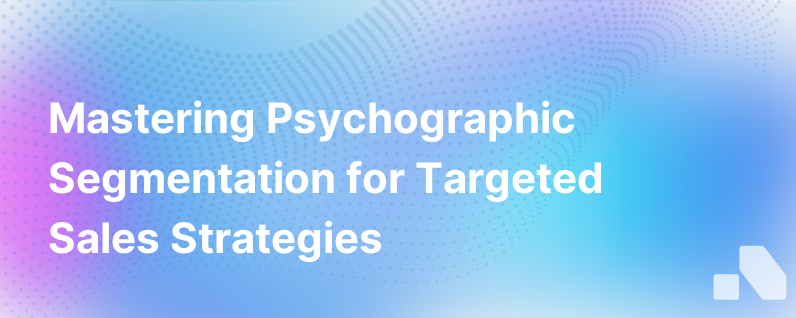
Understanding the unique characteristics of consumers is the cornerstone of any marketing strategy. While demographic segmentation has long been the go-to standard, psychographic segmentation is fast gaining traction as a powerful tool to enhance the efficacy of marketing campaigns. By diving into the psychological attributes of consumers, businesses can create highly targeted campaigns that resonate on a deeper level with their audience.
In this guide, we delve into the nuances of psychographic segmentation, its advantages, how it compares to other segmentation methods, and ways in which it can be effectively implemented to amplify your marketing endeavors.
Understanding Psychographic Segmentation
Psychographic segmentation is an analytic approach that categorizes consumers based on their psychological characteristics, including personality traits, values, attitudes, interests, and lifestyles. This method goes beyond simple demographics to form a more comprehensive understanding of consumers' inner worlds—an understanding that can explain why they make specific purchasing decisions.
Key components of psychographic segmentation include:
- Personality Traits: These might encompass a person's level of extroversion or their openness to new experiences.
- Lifestyle: This examines how individuals choose to live and spend their time, which directly influences buying behaviors.
- Values: Core beliefs and principles that guide an individual's actions and decisions.
- Attitudes and Opinions: These represent individuals’ habitual thinking patterns and feelings about various topics that have been solidified over time.
- Interests and Activities: Hobbies, recreational pursuits, and entertainment preferences that consumers engage in.
The Advantages of Psychographic Segmentation
By segmenting your market based on psychographics, you can craft marketing messages that are impactful and engaging. Here's why psychographic segmentation can be particularly advantageous:
- Personalized Marketing: It enables businesses to speak directly to the emotional and psychological needs of their customers, creating a more personalized marketing approach.
- Competitive Edge: Leveraging psychographics helps in distinguishing your brand, facilitating a more profound connection with consumers.
- Product Development: Insights into consumer psychographics can drive innovation and product development that genuinely reflects consumer desires and lifestyles.
- Advertising Efficiency: Psychographic segmentation allows for more effective ad targeting, ensuring that promotional efforts reach the most receptive audience.
Psychographic vs Demographic Segmentation
While demographics segment markets based on observable, tangible criteria like age, sex, or income, psychographics look at the intangible. Psychographic data might not be as easy to collect, but it provides depth to the insights that demographics alone cannot offer. For example, while demographics may tell you that your target market is women aged 30-40, psychographics would reveal that they're environmentally conscious, fitness enthusiasts who value organic products—detailing not just who they are, but what they believe in and how they live their lives.
Collecting Psychographic Data
To segment consumers psychographically, gather data through:
- Surveys and Questionnaires: Asking direct questions about people's beliefs, values, and lifestyles can yield valuable psychographic data.
- Focus Groups: Dive deep into consumers' psychographic profiles through guided discussions.
- Social Media Analytics: Analyze social media activity to determine interests, opinions, and attitudes.
- Market Research Reports: Look for existing research that may provide psychographic insights relevant to your audience.
- AI and Machine Learning Tools: Use advanced analytics tools like Aomni to extract psychographic data from various digital footprints.
Implementing Psychographic Segmentation
Here's how you can incorporate psychographic segmentation into your marketing strategy:
-
Segment your Audience: Use the psychographic data collected to create distinct consumer profiles or personas. Each persona should represent a segment of your target audience based on their psychological attributes.
-
Tailor Your Messaging: Develop messaging that appeals to the values, beliefs, and lifestyle of each persona. For example, if your psychographic analysis reveals a segment deeply invested in sustainability, your marketing efforts should emphasize your product’s eco-friendly attributes.
-
Customize your Product or Service Offering: Depending on the psychographics of your target segments, customize offerings to meet the specific lifestyle needs and values of your consumers.
-
Select the Right Channels: Choose marketing channels that align with the media consumption habits of your audience. If your segment prefers online communities, for instance, focus on social media marketing.
-
Monitor and Adjust: Like any marketing strategy, psychographic segmentation should not be static. Continuously gather data and refine your segments to ensure they reflect the ever-evolving psychological makeup of your consumers.
Conclusion
Psychographic segmentation is a potent instrument in the marketer's toolkit, enabling a nuanced understanding of consumer behavior. By tapping into the psychological triggers of purchase decisions, businesses can significantly enhance the relevance and effectiveness of their marketing efforts. It’s a qualitative leap beyond the basics, engaging consumers on a personal level and fostering brand loyalty that resonates with their most deeply held values and beliefs.
While the collection and analysis of psychographic data can be complex, the emergence of AI and machine learning platforms like Aomni can streamline this process. Aomni provides business intelligence that aids in uncovering actionable psychographic insights with minimal effort, ensuring that every campaign you craft is optimized to speak directly to the hearts and minds of your consumers. With psychographic segmentation, craft the narratives that will not only capture attention but also convert and cultivate lasting customer relationships.